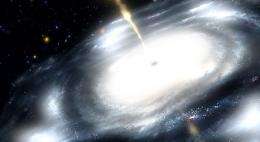March 23, 2012 report
Researchers create computer simulations of primordial black holes striking the Earth

(PhysOrg.com) -- Black holes have captured the imagination of scientists and amateur enthusiasts for years. The idea of some dark entity out there in the far reaches of space sucking up anything and everything that ventures near with such power and force that even light can’t escape it’s clutches, both enthralls and terrifies. Thus, the idea of one moving close enough to our planet would seem good reason to hit the panic button. But, in some cases, it appears, it might not be such a bad thing, at least if it were very, very small. That’s what one small group of researchers has concluded after simulating the effects of one tiny black hole hitting and passing through the Earth, on a computer. They have posted their ideas and conclusions on the preprint server arXiv.
The reason the research team began simulating minuscule black holes and what impact they might have if they struck the Earth, is because they believe that such black holes, if they truly do exist, would have to have dark matter as one of its components. Thus, if they can prove that tiny black holes exist, such as by proving that they have left evidence behind when striking the Earth, they would have gone a long ways towards offering proof that dark matter exists. Something no one else thus far has been able to do.
The good news is that their simulations show that if such black holes did strike the Earth, the impact would be negligible, similar they say, to a very minor earthquake felt all over the planet. This is because they are so small, on the order of the diameter of atomic nuclei and travel so fast. They estimate it would take less than a minute for one to make it all the way through the Earth and out the other side. The bad news, at least for researchers, is that such collisions are only predicted to occur every few million years or so.
But that’s not stopping the team from looking for evidence of past strikes. They note that the famous Tunguska impact in Siberia in 1908 hasn’t been fully explained. They point out that no comet ash has ever been found at the site and wonder if perhaps it was the result of a primordial black hole instead. Thus far, it doesn’t seem likely due to the lack of secondary signatures around what would have to be an exit wound on the other side of the world. But the idea that it could have been a black hole has other researchers intrigued which will likely lead to more research on other impact sites and perhaps proof that at least one of them, was indeed the result of a very tiny black hole passing through.
More information: Detectable seismic consequences of the interaction of a primordial black hole with Earth, arXiv:1203.3806v1 [astro-ph.CO] arxiv.org/abs/1203.3806
Abstract
Galaxies observed today are likely to have evolved from density perturbations in the early universe. Perturbations that exceeded some critical threshold are conjectured to have undergone gravitational collapse to form primordial black holes (PBHs) at a range of masses. Such PBHs serve as candidates for cold dark matter and their detection would shed light on conditions in the early universe. Here we propose a mechanism to search for transits of PBHs through/nearby Earth by studying the associated seismic waves. Using a spectral-element method, we simulate and visualize this seismic wave field in Earth's interior. We predict the emergence of two unique signatures, namely, a wave that would arrive almost simultaneously everywhere on Earth's free surface and the excitation of unusual spheroidal modes with a characteristic frequency-spacing in free oscillation spectra. These qualitative characteristics are unaffected by the speed or proximity of the PBH trajectory. The seismic energy deposited by a proximal ${M^{PBH} = 10^{15}}$ g PBH is comparable to a magnitude $M_w=4$ earthquake. The non-seismic collateral damage due to the actual impact of such small PBHs with Earth would be negligible. Unfortunately, the expected collision rate is very low even if PBHs constituted all of dark matter, at ${sim 10^{-7} {yr}^{-1}}$, and since the rate scales as ${1/M^{PBH}}$, fortunately encounters with larger, Earth-threatening PBHs are exceedingly unlikely. However, the rate at which non-colliding close encounters of PBHs could be detected by seismic activity alone is roughly two orders of magnitude larger --- that is once every hundred thousand years --- than the direct collision rate.
© 2011 PhysOrg.com



















